英语语言学--语用学
英语语言学知识点总结

英语语言学知识点总结
英语语言学是研究英语语言及其发展历史、语音、语法、词汇、语用等方面的学科。
以下是一些英语语言学的知识点总结:
1. 英语语音学:英语语音学主要研究英语的发音、声调、重音等语音现象。
其中,英语的发音规则主要包括元音、辅音和声调等方面的规则。
2. 英语语法学:英语语法学主要研究英语的语法结构和规则,包括句子结构、时态、语态、名词、形容词、副词等语法范畴。
3. 英语词汇学:英语词汇学主要研究英语的词汇构成、演化和使用情况,包括单词、词组和习语等方面的研究。
4. 英语语用学:英语语用学主要研究英语的语用功能和语境,包括语言交际、暗示、礼貌、语用失误等方面的研究。
5. 英语语音语调学:英语语音语调学主要研究英语的语音语调系统,包括英语的发音、声调、重音、节奏等方面的研究。
6. 英语文体学:英语文体学主要研究英语的文体风格和语言习惯,包括正式文体、口语文体、文学文体等方面的研究。
7. 英语词汇记忆学:英语词汇记忆学主要研究如何有效地记忆英语词汇,包括词汇记忆的方法、技巧和策略等方面的研究。
8. 英语跨文化交际学:英语跨文化交际学主要研究英语在不同文化中的交际和使用,包括跨文化沟通、文化差异、交际礼仪等方面的研究。
以上是一些英语语言学的重要知识点总结,不同学科之间的交叉
和融合也在不断推进着英语语言学的发展。
英语语言学 6 语用学
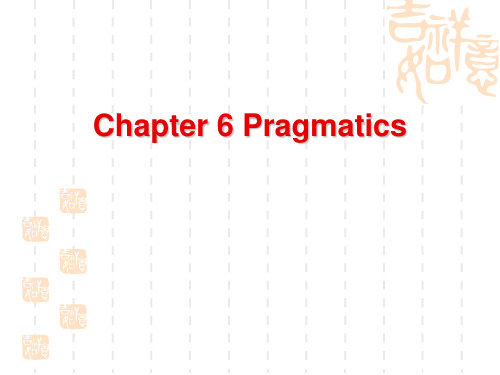
because the speakers understand each other’s illocutionary acts: ▪ (1) Making a request of his wife to go and answer the phone. ▪ (2) A refusal to comply with the request; issuing a request of her husband to answer the phone instead. ▪ (3) Accepting the wife’s refusal and accepting her request, meaning “all right, I’ll answer it.”
▪ 言语行为一词源于哲学家J. L. Austin(1962)的著作,现
在用来指一种理论,该理论分析话语在人际交往中与说 话者和听话人的行为之间的关系。它旨在回答 “我们在 使用语言时究竟在做什么?”这个问题。
Two types of utterances
▪ Constatives (叙述话语) ---- statements that either state or describe, and are thus verifiable;
Some basic notions in Pragmatics
▪ Pragmatics vs. Semantics 语用学与语义学
▪ Context 语境
▪ Sentence meaning vs. utterance meaning 句子意义和话语意义
(827)英语语言学知识

英语语言学是研究英语语言的科学领域,它涵盖了英语的语音、语法、词汇、句法、语义以及语用等方面的研究。
本文将从不同角度介绍英语语言学的基本概念、研究方法以及一些相关的重要理论。
一、语音学语音学是研究语音的科学,它关注的是语音的产生、传播和感知。
在英语语言学中,我们需要了解英语的音素和音系,即英语中的音位和音位之间的关系。
此外,我们还需要了解如何正确地发音,包括英语的元音和辅音。
二、语法学语法学是研究语言的结构和规则的科学,它关注的是语言中单词和句子的组成以及它们之间的关系。
在英语语言学中,我们需要了解英语的基本句型和句子成分的分类。
同时,我们还需要学习英语的时态、语态和语气等语法现象。
三、词汇学词汇学是研究词汇的科学,它关注的是词汇在语言中的作用和使用。
在英语语言学中,我们需要了解英语的词汇分类和词义的多样性。
同时,我们还需要学习如何正确地使用英语词汇,包括词汇的拼写和用法。
四、句法学句法学是研究句子结构和句子成分的科学,它关注的是句子的组成和句子成分之间的关系。
在英语语言学中,我们需要了解英语句子的基本结构和句子成分的分类。
同时,我们还需要学习如何正确地构造和分析英语句子。
五、语义学语义学是研究语言意义的科学,它关注的是语言中词汇和句子的意义。
在英语语言学中,我们需要了解词汇的意义和句子的意义,包括词语之间的关联和句子的推理。
同时,我们还需要学习如何正确地理解和表达英语的语义内容。
六、语用学语用学是研究语言使用的科学,它关注的是语言在社交交际中的实际运用。
在英语语言学中,我们需要了解英语的语用规则和语用策略,包括言语行为和话语的意图。
同时,我们还需要学习如何在不同语境下使用英语,以达到有效交流的目的。
《(827)英语语言学知识》是一篇关于英语语言学基本概念、研究方法和相关理论的文档。
通过学习语音学、语法学、词汇学、句法学、语义学和语用学等方面的知识,我们可以更好地理解和运用英语语言。
希望本文能够帮助读者对英语语言学有更深入的了解和认识。
英语语言学分支

英语语言学分支(原创实用版)目录1.英语语言学的分支概述2.语音学3.语法学4.语义学5.语用学6.语言学与其他学科的联系正文一、英语语言学的分支概述英语语言学作为语言学的一个重要分支,主要研究英语的语音、语法、语义、语用等方面的规律。
英语语言学可以分为多个子领域,每个子领域都有其独特的研究方法和目标。
本文将对英语语言学的主要分支进行简要介绍。
二、语音学语音学是研究语音现象的学科,主要关注发音、声调、音位等方面的问题。
在英语语音学中,研究者需要分析英语音标的发音规律,以及不同口音和方言的特点。
此外,语音学还涉及到语音识别和合成等领域。
三、语法学语法学是研究语言结构的学科,主要关注词汇、句子和篇章的组织规律。
在英语语法学中,研究者需要分析英语单词的词性、词序、句子成分等方面的问题。
语法学的研究成果对语言教学、翻译和自然语言处理等方面具有重要意义。
四、语义学语义学是研究语言意义的学科,主要关注词汇、句子和篇章的含义。
在英语语义学中,研究者需要分析英语单词和句子的意义、语义关系等方面的问题。
语义学的研究成果有助于提高语言表达的准确性和理解能力。
五、语用学语用学是研究语言使用情况的学科,主要关注语言在不同情境下的功能和效果。
在英语语用学中,研究者需要分析英语在不同语境、交际目的和文化背景中的使用规律。
语用学的研究成果对跨文化交际、语言教学和翻译等方面具有重要意义。
六、语言学与其他学科的联系英语语言学与许多其他学科有着密切的联系,如心理学、社会学、哲学、计算机科学等。
这些学科的研究成果为英语语言学的研究提供了丰富的理论资源和方法论支持。
同时,英语语言学的研究成果也在这些学科领域产生了广泛的应用价值。
总之,英语语言学作为一个多元化的学科体系,其各个分支领域都有独特的研究内容和方法。
英语语言学大全
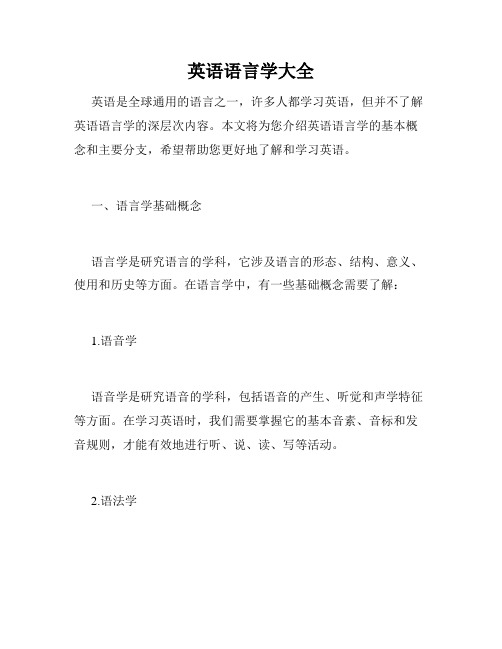
英语语言学大全英语是全球通用的语言之一,许多人都学习英语,但并不了解英语语言学的深层次内容。
本文将为您介绍英语语言学的基本概念和主要分支,希望帮助您更好地了解和学习英语。
一、语言学基础概念语言学是研究语言的学科,它涉及语言的形态、结构、意义、使用和历史等方面。
在语言学中,有一些基础概念需要了解:1.语音学语音学是研究语音的学科,包括语音的产生、听觉和声学特征等方面。
在学习英语时,我们需要掌握它的基本音素、音标和发音规则,才能有效地进行听、说、读、写等活动。
2.语法学语法学是研究语言结构和组织的学科,有时也称为句法学。
它研究语言的词类、句子结构、语法关系等方面。
通过学习英语的语法,我们可以正确使用语言,避免出现语法错误。
3.语义学语义学是研究语言意义的学科,它探究词汇、短语和句子意义的形成和变化。
在英语学习中,我们需要理解单词和短语的意义,以及句子的含义,以便正确理解和表达内容。
4.语用学语用学是研究语言使用的学科,包括口语和书面语言的使用场合、对话方式、说话人的语言目标和对听者的影响等方面。
在英语学习中,我们需要了解不同场合和对象的语言使用规范,以便与人交流时更加得心应手。
二、英语语言学的主要分支除了以上基础概念外,英语语言学还有一些重要的学术分支,能够帮助我们更深入地了解和掌握英语。
1.语音学英语语音学探究的是英语中的音素、音标和发音规则等方面,以及与其他语音系统的比较和差异。
2.语法学英语语法学研究的是英语的句法结构、语法关系和句子意义等方面,以及与其他语言的比较和翻译问题。
3.词汇学英语词汇学是研究英语词汇的学科,包括单词的来源、组成和意义等方面,以及与其他语言的比较和词汇翻译问题。
4.语用学英语语用学研究的是英语在语言使用中的实际应用,包括语言交际、言语行为、语境和语言目的等方面。
5.文本语言学英语文本语言学是研究英语文本的结构、组织和语言特点等方面的学科,包括语篇分析和修辞分析等内容。
语用学名词定义

语用学名词定义语用学(pragmatics)语言学、哲学和心理学的一个分支学科,研究脉络如何影响人运用和理解语言。
语用学分析研究影响语言行为(如招呼、回答、应酬、劝说)的标准和支配轮流发言的规则。
语用学还研究语言用于成事的方式。
例如,「我允诺」用于特定语境中就是允诺。
语用学yǔyòngxué[pragmatics]符号学的一个分支,研究符号或语言词句与其使用之间的关系。
语用学是语言学各分支中一个以语言意义为研究对象的新兴学科领域,是专门研究语言的理解和使用的学问,它研究在特定情景中的特定话语,研究如何通过语境来理解和使用语言。
语用学因其本身的目的性和价值性而不同于语法研究,它是关于人类语言本身的研究。
在语言的使用中,说话人往往并不是单纯地要表达语言成分和符号单位的静态意义,听话人通常要通过一系列心理推断,去理解说话人的实际意图。
要做到真正理解和恰当使用一门语言,仅仅懂得构成这门语言的发音、词汇和语法是远远不够的。
语用学的另一核心概念就是意义。
何兆熊先生(1987)在他的语用学概要一书中指出:―在众多的语用学定义中,有两个概念是十分基本的,一个是意义,另一个是语境。
‖从发展的观点看,语用学的崛起是语义研究的发展和延伸的结果,因此可以说语用学是一种对意义的研究。
但语用学所研究的意义不同于形式语义学所研究的意义,它所研究的是语言在一定的语境中使用时体现出来的具体意义。
由此可知,语境对意义的作用在语用学研究中十分重要。
研究在一定的上下文里语言的使用,包括所产生的字面意义和蕴涵意义,以及可能产生的效果的学科。
语用学的概念首先是美国哲学家C.W.莫里斯(1901~1979)和R.卡纳普(1891~1970)在20世纪30年代前后提出的。
60年代,英国哲学家J.L.奥斯汀(1912~1960)和J.塞尔勒(1932~)先后发表了―语言行为‖的理论;美国语用学家P.格赖斯提出了―会话中合作原则‖的理论。
(完整word版)语用学概要

第一章绪论1。
11.“pragma—”这个拉丁词根具有“做、行动”这一意思。
从广义上说,pragmatics指的是对人类有目的的行为所做的研究。
如果做这种理解的话,或许翻译为“行为学”更恰当.人类有目的的行为涉及人的所信、目的、策划和行为。
学术界首先提出这一术语的不是语言学家,而是哲学家。
2.最早使用pragmatics这一术语的是美国哲学家C。
Morris和R。
Carnap。
3.语境。
构成语境的语言外知识可分为三大类:背景知识,情景知识,交际双方相互了解。
4.交际过程也就是语境的建构过程.发话者能够有意识地“操纵”共有知识来建构有利于达到自己交际目的的语境。
(何兆熊蒋艳梅1997)1.41.语义学最广义的理解,也许可以把语用学对意义的研究纳入语义学中去。
2.语义学和语用学的共同点在于,都是对意义的研究。
但是属于两个不同层面的对意义的研究,这两种意义研究的关联性是十分明显的。
语义学对意义的研究是基本的,没这一层次的研究很难进行第二层次的研究。
语用意义不能脱离语言本身固有的内在意义。
语义学是对抽象语言能力的研究,语用学是对言语行为的研究,言语行为是语言能力的具体体现。
第二章意义和所指2。
11.越来越多的语言学家发现,对“意义和所指”只有结合话语的上下文和语境才能做出较充分的阐释和校准确的把握。
2.语义学一般将词汇意义划分为两个不同但彼此互补的层面,即外延(denotation)和意义(sense)。
一个语言表达式的外延一般是固定不变的,独立于具体的话语语境之外,这一层的语义存在于语言系统之内,独立于话语使用的特定语境。
所谓的意义通常处于变化不定的状态,而且随着语境的变化而变化。
(例如dog)因此,单个词素没有所指,但可以用作指称语的组成部分而被用语不同的话语和语境中。
3.为什么词项的系统意义和外延带有的边界模糊性不会影响交际的成功呢?认知语言学认为:人们对客观实体的感知和把握主要借助于大脑中业已积淀下来的、有关客观实体的“原型",人们对所指的对象一般均符合某一事物的“原型”。
英语语言学分支

英语语言学分支语言学是研究语言的科学,包括多个分支,每个分支关注语言的不同方面。
以下是一些主要的英语语言学分支:1. 音韵学(Phonetics and Phonology):研究语音的产生、传播和接收,以及语音单位在语言中的组合和分布。
音韵学关注语音的物理性质和声学特征。
2. 形态学(Morphology):研究语言中的词的内部结构和形态变化。
形态学关注单词如何形成,以及单词内部构建的规则。
3. 句法学(Syntax):研究句子的结构,包括词与词之间的关系,以及句子的组成方式。
句法学关注语法规则是如何用来生成合乎语法规范的句子的。
4. 语义学(Semantics):研究词和句子的意义。
语义学关注语言中词汇和句法单位的意义,以及它们如何组合形成合适的语言表达。
5. 语用学(Pragmatics):研究语言使用的上下文依赖性和语境中的语言交际。
语用学关注说话者和听话者之间的信息传递,以及言语行为在特定情境中的作用。
6. 社会语言学(Sociolinguistics):研究语言和社会之间的关系。
社会语言学关注方言、语言变异、语言政策等与社会因素相关的语言现象。
7. 心理语言学(Psycholinguistics):研究语言的心理过程,包括语言习得、语言记忆、语言理解等。
心理语言学关注语言在认知过程中的作用。
8. 历史语言学(Historical Linguistics):研究语言的历史演变和变化。
历史语言学关注语言家族、语言演化、语言接触等方面的变化。
9. 比较语言学(Comparative Linguistics):研究不同语言之间的相似性和差异。
比较语言学关注语言之间的语法结构、词汇和语音的比较。
这些分支共同构成了语言学的广阔领域,每个分支都有其独特的研究对象和方法。
英语语言学现象举例
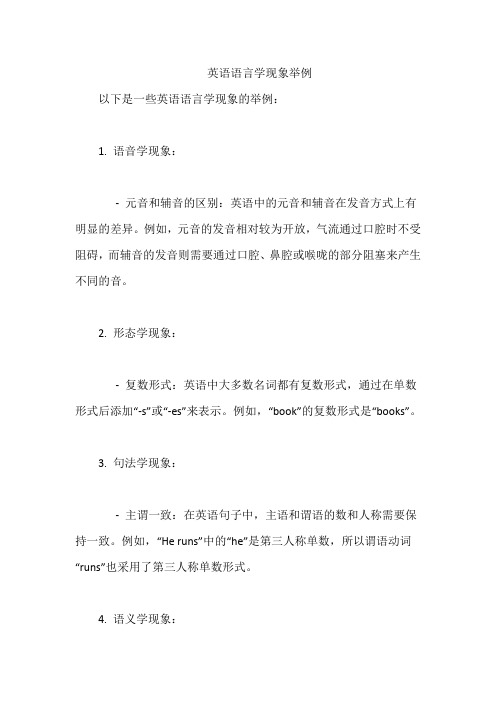
英语语言学现象举例
以下是一些英语语言学现象的举例:
1. 语音学现象:
- 元音和辅音的区别:英语中的元音和辅音在发音方式上有明显的差异。
例如,元音的发音相对较为开放,气流通过口腔时不受阻碍,而辅音的发音则需要通过口腔、鼻腔或喉咙的部分阻塞来产生不同的音。
2. 形态学现象:
- 复数形式:英语中大多数名词都有复数形式,通过在单数形式后添加“-s”或“-es”来表示。
例如,“book”的复数形式是“books”。
3. 句法学现象:
- 主谓一致:在英语句子中,主语和谓语的数和人称需要保持一致。
例如,“He runs”中的“he”是第三人称单数,所以谓语动词“runs”也采用了第三人称单数形式。
4. 语义学现象:
- 多义词:英语中许多单词具有多种不同的意义,这称为多义词。
例如,“run”这个单词可以表示“跑步”、“经营”、“流淌”等多种意义,具体含义取决于上下文。
5. 语用学现象:
- 礼貌用语:英语中有一些特定的表达方式用于表示礼貌和尊重。
例如,“please”和“thank you”是常用的礼貌用语,用于请求和表达感谢。
英语语言文学 语言学方向
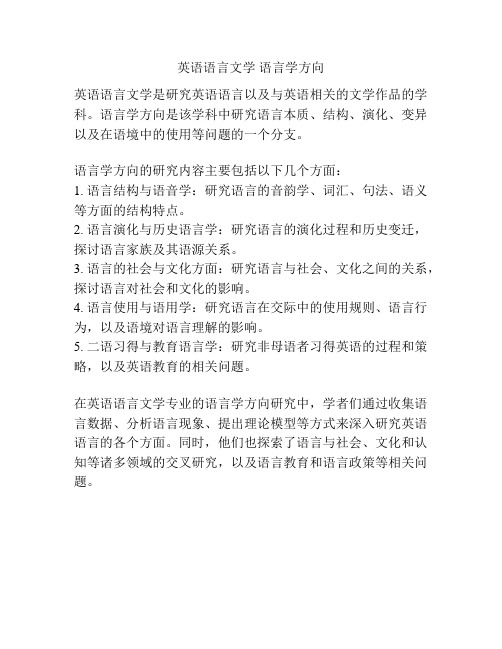
英语语言文学语言学方向
英语语言文学是研究英语语言以及与英语相关的文学作品的学科。
语言学方向是该学科中研究语言本质、结构、演化、变异以及在语境中的使用等问题的一个分支。
语言学方向的研究内容主要包括以下几个方面:
1. 语言结构与语音学:研究语言的音韵学、词汇、句法、语义等方面的结构特点。
2. 语言演化与历史语言学:研究语言的演化过程和历史变迁,探讨语言家族及其语源关系。
3. 语言的社会与文化方面:研究语言与社会、文化之间的关系,探讨语言对社会和文化的影响。
4. 语言使用与语用学:研究语言在交际中的使用规则、语言行为,以及语境对语言理解的影响。
5. 二语习得与教育语言学:研究非母语者习得英语的过程和策略,以及英语教育的相关问题。
在英语语言文学专业的语言学方向研究中,学者们通过收集语言数据、分析语言现象、提出理论模型等方式来深入研究英语语言的各个方面。
同时,他们也探索了语言与社会、文化和认知等诸多领域的交叉研究,以及语言教育和语言政策等相关问题。
英语语言学 语用学 Pragmatics
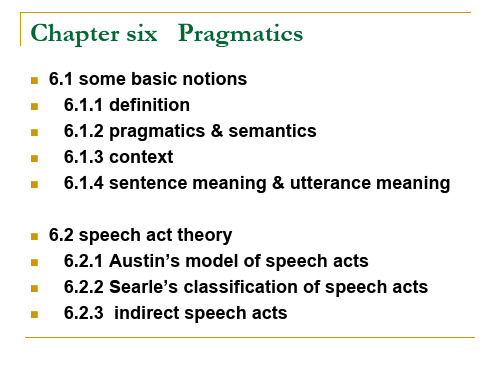
The essential distinction between semantics and pragmatics is whether the context of use is considered in the study of meaning.
6.1.2 pragmatics and semantics
related but different linguistic studies of meaning both study meaning
Semantics treats meaning as an abstract, self contained, intrinsic system, a property attached to language itself, which is not influenced by context.
研究语言使用者是如何使用句子成功进行交际 的
It is a discipline of studying meaning not in isolation, but in context.
Pragmatics: the study of linguistic acts and the contexts in which they are performed
因此在研究语义时是否考虑语境便成了传统语 义学和语用学的根本区别所在。
如 It is cold in here 这个句子,对传统语义学 家来说,只是表达了“某一地点气温比较低” 这样的命题内容。而对语用学家来说,除了陈 述一个客观的气温情况外,说话人很可能是为 了请听话人做点什么,如关上窗户、打开暖气、 借件衣服御寒等。
英语语言学 语义学 语用学的区别
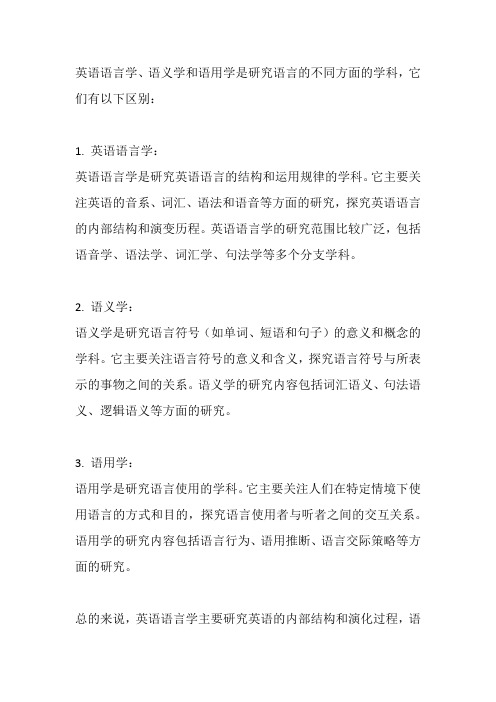
英语语言学、语义学和语用学是研究语言的不同方面的学科,它们有以下区别:
1. 英语语言学:
英语语言学是研究英语语言的结构和运用规律的学科。
它主要关注英语的音系、词汇、语法和语音等方面的研究,探究英语语言的内部结构和演变历程。
英语语言学的研究范围比较广泛,包括语音学、语法学、词汇学、句法学等多个分支学科。
2. 语义学:
语义学是研究语言符号(如单词、短语和句子)的意义和概念的学科。
它主要关注语言符号的意义和含义,探究语言符号与所表示的事物之间的关系。
语义学的研究内容包括词汇语义、句法语义、逻辑语义等方面的研究。
3. 语用学:
语用学是研究语言使用的学科。
它主要关注人们在特定情境下使用语言的方式和目的,探究语言使用者与听者之间的交互关系。
语用学的研究内容包括语言行为、语用推断、语言交际策略等方面的研究。
总的来说,英语语言学主要研究英语的内部结构和演化过程,语
义学主要研究语言符号的意义和概念,而语用学则主要关注语言使用的方式和目的。
这三门学科虽然各自研究不同的方面,但它们之间也有相互关联和交叉的地方,共同构成了对语言的全面研究。
英语专业语言学方向

英语专业语言学方向
英语专业中的语言学方向是研究语言的结构、功能和发展规律的学科。
在语言学方向中,主要关注的是英语语言的各个层面,包括语音学、语法学、语义学、词汇学、语用学等。
1. 语音学(Phonetics):研究语音和发音的学科。
它包括对语音单位(音位)的分类和描述,以及语音的产生、传播和感知等方面的研究。
2. 语言音系学(Phonology):研究语音在特定语言中的组合和规则。
它研究的是语音的功能和意义,以及不同语音之间的变化和相互关系。
3. 语法学(Grammar):研究语言的句法结构和句子的组织规则。
它关注句子的成分、句子类型、句法关系等方面,以及不同句式和语法现象的分析和解释。
4. 语义学(Semantics):研究语言中词汇和句子的意义和含义。
它涉及符号的指称、概念的表达、意义的推理等问题,并探讨语言与思维、社会文化背景之间的关系。
5. 词汇学(Lexicology):研究语言中词汇的产生、变化和使用规律。
它研究词汇的分类、构词法、词义等问题,并分析词汇在句子中的作用和语言变异现象。
6. 语用学(Pragmatics):研究语言使用和交际的学科。
它关注语言的意图、指代、语境、说话人意向等方面,以及语言行为的目的和效果。
此外,还有与语言学密切相关的领域,如文体学(Stylistics)、社会语言学(Sociolinguistics)、心理语言学(Psycholinguistics)等。
这些方向在深入研究与英语语言相关的领域和问题时也起到重要的作用。
英语专业语用学试卷
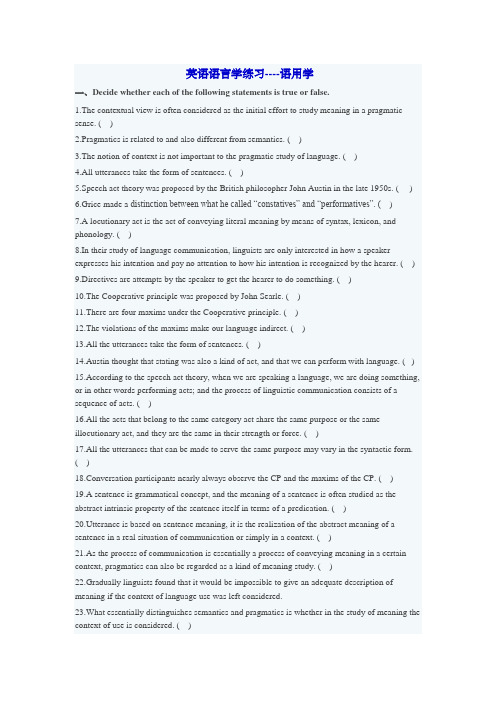
英语语言学练习----语用学一、Decide whether each of the following statements is true or false.1.The contextual view is often considered as the initial effort to study meaning in a pragmatic sense. ( )2.Pragmatics is related to and also different from semantics. ( )3.The notion of context is not important to the pragmatic study of language. ( )4.All utterances take the form of sentences. ( )5.Speech act theory was proposed by the British philosopher John Austin in the late 1950s. ( )6.Grice made a distinction between what he called “constatives” and “performatives”. ( )7.A locutionary act is the act of conveying literal meaning by means of syntax, lexicon, and phonology. ( )8.In their study of language communication, linguists are only interested in how a speaker expresses his intention and pay no attention to how his intention is recognized by the hearer. ( )9.Directives are attempts by the speaker to get the hearer to do something. ( )10.The Cooperative principle was proposed by John Searle. ( )11.There are four maxims under the Cooperative principle. ( )12.The violations of the maxims make our language indirect. ( )13.All the utterances take the form of sentences. ( )14.Austin thought that stating was also a kind of act, and that we can perform with language. ( )15.According to the speech act theory, when we are speaking a language, we are doing something, or in other words performing acts; and the process of linguistic communication consists of a sequence of acts. ( )16.All the acts that belong to the same category act share the same purpose or the same illocutionary act, and they are the same in their strength or force. ( )17.All the utterances that can be made to serve the same purpose may vary in the syntactic form. ( )18.Conversation participants nearly always observe the CP and the maxims of the CP. ( )19.A sentence is grammatical concept, and the meaning of a sentence is often studied as the abstract intrinsic property of the sentence itself in terms of a predication. ( )20.Utterance is based on sentence meaning, it is the realization of the abstract meaning of a sentence in a real situation of communication or simply in a context. ( )21.As the process of communication is essentially a process of conveying meaning in a certain context, pragmatics can also be regarded as a kind of meaning study. ( )22.Gradually linguists found that it would be impossible to give an adequate description of meaning if the context of language use was left considered.23.What essentially distinguishes semantics and pragmatics is whether in the study of meaning the context of use is considered. ( )24.Without the shared knowledge both by the speaker and the hearer, linguistic communication would not be possible, and without considering such knowledge, linguistic communication cannot be satisfactorily accounted for in a semantic sense. ( )25.An perlocutionary act is the act of expressing the speaker’s intention. ( )26.According to Paul Grice’s idea, in making conversation, the participants must first of all be willing to cooperate, otherwise, it would not be possible for them to carry on the talk. ( )27.An illocutionary act is the consequence of or the change brought about by the utterance. 【Keys】:1. T2. T3.F4.F5.T6.F7.T8.F9.T 10.F11. T 12.T 13.F 14.T 15.T 16. F 17. T 18.F 19.T 20.T21. T 22.F 23.T 24.F 25.F 26. T 27. F二、Fill each of following blanks with one word which begins with the letter given.1. The shared knowledge which constitutes context is of two types; the knowledge of thel________ they use, and the knowledge about the w_______, including the general knowledge about the world and specific knowledge about the situation in which linguistic communication is taking place.2. If we think of a sentence as what people actually utter in the course of communication, it becomes an u________, and it should be considered in the situation in which it is actually used.3. The idea of Paul Grice is that in making conversation, the participants must first of all be willing to c_______, otherwise, it would be impossible for them to carry on the talk. The general principle is called the c________ p_________, abbreviated as CP.4. There are four maxims under the CP: the maxim of quantity, the maxim of q_________, the maxim of relation and the maxim of m____________.5. The maxim of relation requires that what the conversation participants say must ber__________.6. As the process of communication is essentially a process of conveying meaning in a certain context, p__________ can be regarded as a kind of meaning study.7. If c___________ is not considered, the study of meaning is restricted to the area of traditional semantics.8. The meaning of an u__________ is concrete and context-dependent.9. An i___________ act is the act of expressing the speaker’s intention.10. According to Seale, s__________acts fall into five general categories.11. C__________ are those speech acts whose point is to commit the speaker to some future course of action.12. To ask someone to pass a book is obviously a d__________.13. According to Paul Grice, in making c__________ the participants must first of all be willing to cooperate.14. Most of the violations of the four maxims give rise to c___________ implicatures.15. The significance of Grice’s c___________ principle lies in that it explains how it is possible for the speaker to convey more than is literally said.【Keys】:1. language, word2. utterance3. cooperate, Cooperative Principle4. quality,mannar 5. relevant6. pragmatics7. context8. utterance9. illocutionary 10. speech 11. Commissive 12. dirextive 13. conversation 14. conversational15. Cooperative三、There are four choices following each statement. Mark the choice that can best complete the statement.1. __________ resulted mainly from the eapansion of the study of linguistics, especially that of semantics.A. PragmaticsB. PragmatismC. PhonologyD. Practicalism2. Once the notion of _________ was taken into consideration, semantics spiiled into pragmatics.A. meaningB. contextC. formD. content3. If a sentence is regarded as what people actually utter in the course of communication, it becomes _______.A. a sentenceB. an actC. a unitD. an utterance4. A ___________ analysis of an utterance will reveal what the speaker intends to do with it.A. semanticB. syntacticC. pragmaticD. grammatical5. _______ act theory is an important theory in the pragmatic study of language.A. SpeakingB. SpeechC. SoundD. Spoken6. ______ act is the act performed by or resulting from saying something.A. A locutionaryB. An illocutionaryC. A perlocutionaryD. A speech7. One of the contributions Searle has made is his classification of __________ acts.A. locutionaryB. illocutionaryC. perlocutionaryD. speech8. The illocutionary point of __________ is to express the psychological state specified in the utterance.A. directivesB. commisivesC. expressivesD. declarations9. All the utterance that can be made to serve the same purpose may vary in their _________ form.A. syntacticB. semanticC. grammaticalD. pragmatic10. The cooperative Principle is proposed by ________.A. John SearleB. John AustinC. Paul GriceD. John Lyons11. Linguists found that it would be impossible to give an adequate description of meaning if the ________ of language use was left unconsidered.A. brevityB. contextC. accuracyD. none of the above12. Of the three speech acts, linguistic are most interested in the _________.A. locutionary actB. perlocutionary actC. illocutionary actD. none of the above13. The maxim of quantity requires: ___________.A. make your contribution ad informative as required.B. Do not make contribution more informative than is required.C. Do not say that for which you lack adequate evidence.D. Both A and B.14. The maxim of quality requireds: do not say what you believe to be ________.A. falseB. trueC. briefD. orderly15. Most of the violations of the maxims of the CP give rise to _______.A. utterance meaningB. speech act theoryC. conversational implicaturesD. all of the above.16. The significance of Grice’s CP lies in that it explains how it is possible for the speaker to convey _________ is literally said.A. more thanB. less thanC. the same asD. none of the above.【Keys】:1. A2. B3. D4. C5. B6. C7. B8. C9. A 10. C 11. B 12. C 13. D 14.A 15. C 16. A四、Define the following terms.1. context2. utterance meaning3. locutionary act4. illocutionary act5. perlocutionary act【Keys】:1. Context is regarded as constituted by all kinds of knowledge assumed to be shared by the speaker and the hearer.2. Utterance meaning is the realization of the abstract meaning of a sentence in a real situation of communication, or simply in a context; it is concrete and dependent on the context.3. A locutionary act is the act of uttering words, phrases, and clauses. It is the act of conveying literal meaning by means of syntax, lexicon and phonology.4. An illocutionary act is the act of expressing the speaker’s intention; it is the act performed in saying something.5. A perlocuionary act is the act performed or resulting from saying something; it is the consequence of, or resulting saying something.。
英语语言学专业术语

英语语言学专业术语英语语言学是研究英语语言的起源、发展、结构和使用的学科。
以下是常见的英语语言学专业术语及其解释。
1. Phonetics(音系学):研究语音的学科。
主要研究语音发音过程,包括语音的组成、发音方式和特点等。
2. Phonology(音韵学):研究语音在语言中的功能和规律的学科。
主要研究语音在不同语境下的变化规律和相互关系,包括音素、音位和音系等。
3. Morphology(形态学):研究语言中单词的形态和构成的学科。
主要研究单词的基本单位和构成规律,包括词根、词缀和词类等。
4. Syntax(句法学):研究句子结构和句子组成的学科。
主要研究句子的构成和排列方式,包括短语、从句和主谓结构等。
5. Semantics(语义学):研究语言意义的学科。
主要研究语言符号和意义之间的关系,包括单词、短语和句子的意义等。
6. Pragmatics(语用学):研究语言使用的学科。
主要研究语言与社会文化环境的关系,包括语境、语用规则和交际意图等。
7. Discourse analysis(话语分析):研究语篇结构和语篇功能的学科。
主要研究语言在话语交际中的组织和作用,包括话语行为、话语结构和话语分析方法等。
8. Sociolinguistics(社会语言学):研究语言和社会文化因素之间的关系和影响的学科。
主要研究不同社会群体、文化背景和地理区域中语言使用的差异和变化,包括方言、语言变体和语言政策等。
9. Psycholinguistics(心理语言学):研究语言和心理过程之间的关系的学科。
主要研究语言理解、语言产生和语言习得等心理过程,包括语音知觉、语法处理和语言记忆等。
以上是英语语言学常见的专业术语及其解释,希望能够帮助你更好地了解英语语言学。
英语语言学语言学知识点

英语语言学语言学知识点语言学是一门研究语言的学科。
它涵盖了多个领域,包括语音学、语法学、语义学、语用学和语言变化等。
下面将简要介绍一些语言学的重要知识点。
一、语音学(Phonetics)语音学是研究语音的学问。
它关注语音的产生、传播和感知等方面。
在语音学中,语音被分为音素(phoneme)和音位(allophone)。
音素是语言中最小的语音单位,可以在语言中起到区分意义的作用。
而音位是相同意义的不同实现方式,即同一音素的不同发音形式。
在语音学中,还有一些重要概念,如元音(vowel)和辅音(consonant)。
元音是语音学中最基本、最重要的音类,它们的发音不受任何阻塞或摩擦的干扰。
而辅音则需要通过口腔或喉头的阻塞或摩擦才能产生。
二、语音语调学(Phonology)语音语调学是研究语音和语调现象的学问。
它研究语音和语音的组织方式和相互关系。
在语音语调学中,音位和音位组成规则是核心概念之一、音位组成规则决定了在一个语言中哪些音位可以成为合法的音节。
此外,在语音语调学中还有音变(phonological variation)的概念。
音变指的是在其中一种语言中,一个特定音位的发音方式会随着不同的语音环境而发生变化的现象。
音变是语言变化的一种重要表现。
三、语法学(Grammar)语法学是研究语言的结构和规则的学问。
在语法学中,句子是一个重要的研究对象。
句子结构可以划分为短语(phrase)和句子成分(sentence constituents),如名词短语、动词短语和介词短语等。
语法学还涉及到句子的成分顺序和组成规则。
在语法学中,句法树(syntactic tree)是一种图形表示方式,用于描述句子的结构。
句法树由句子的各个成分和它们之间的关系构成。
四、语义学(Semantics)语义学是研究词汇和句子意义的学问。
它关注词语和句子的语义性质、意义的产生机制以及词义的转换等。
在语义学中,可以通过语义角色(semantic role)和逻辑关系(logical relation)来描述词语和句子之间的关系。
英语语言学-语言学知识点
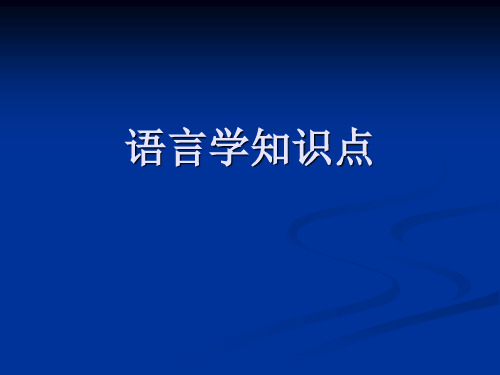
东支 罗马尼亚语
West Slavic group 斯拉夫语西支 波兰语,捷克语
东支 俄语
Important Distinctions in Linguistics
3). langue(语言) & parole (言语) Theorist:Saussure(索绪尔), father of
举例: Sounds > syllables > words > phrases > clauses > sentences> texts/discourses
3) Creativity/Productivity(创造性): 定义:Language can be used to create new
modern linguistics langue: abstract linguistic system parole: actual realization of langue
Important Distinctions in Linguistics
举例: 汉语系统 langue 每个中国人在不同具体场景
MicroLinguistics
sound
word
sentence
meaning
Phonetics (语音学)
Morphology
Syntax
Semantics
(形态学) (句法学) (语义学)
Phonology (音系学)
Pragmatics (语用学)
语言学分类-按研究内容分
MicroLinguistics
语音学分类
articulatory phonetics(发音语音学): speaker’s production
什么是语用学

值得一提的是,汉语语法学界从七十年 代末八十年代初就借鉴国外句法学、语用学 和语义学的相关理论,形成了三个平面的语 法理论,倡导语法研究应该把句法平面、语 义平面和语用平面区分开来,在具体的研究 中又要有效地结合起来。这一理论在语法学 界形成了广泛的影响,成为八十年代以来直 到今天语法研究的新理论和研究热点。这一 理论的倡导者为胡裕树、张斌、范晓等。
“今天是星期天。”表意有多少?
同一个话语在不同语境下可能传递的隐含信息,类似信息 远不是其表面意义。 情景1:丈夫潜心事业,不知休息,妻子出于关心, 在星期天对丈夫如是说。 情景2:丈夫不干家务,但答应妻子星期天帮忙, 到了星期天上午十点仍在床上看电视,此时妻子对丈夫 如是说。 情景3:父亲工作忙,平时很少陪孩子玩,在孩子 的要求下,父亲答应星期天带孩子去动物园,但到了星 期天父亲又要到公司,此时孩子对父亲如是说。 …… ……
四、汉语语用学的研究课题
1、语境与语用 2、汉语的口气 3、汉语的话题和话题结构 4、汉语的焦点及焦点结构 5、汉语的言外之意 6、汉语语序 7、汉语的合作原则与礼貌原则 8、汉语的语气与言语行为
汉语语用学的研究方法
一、变异法 从言语的变异中寻求汉语的语用的规律。
“教我的那个韩国教练个子很高,皮肤黝黑,据说 是前国家滑雪队运动员,他的英语说得一塌糊涂,滑雪 的姿势帅得一塌糊涂,但也英俊得一塌糊涂。” 《中国民航》2004年第六期:〈雪舞南山,淡天一 片琉璃〉
(二)国内语用学的研究现状 上世纪八十年代初,外语界学者就 将语用学介绍到了国内。随后出版了为 数可观的评介、研究的著作、文章。胡 壮麟(1980)的“语用学”是国内最早 介绍该学科的文章。何自然的《语用学 概论》(1988)、何兆熊的《语用学概 要》(1989)是最早系统介绍语用学的 著作。研究集大成文献:束定芳(2001) 主编的《中国语用学研究论文精选》。
- 1、下载文档前请自行甄别文档内容的完整性,平台不提供额外的编辑、内容补充、找答案等附加服务。
- 2、"仅部分预览"的文档,不可在线预览部分如存在完整性等问题,可反馈申请退款(可完整预览的文档不适用该条件!)。
- 3、如文档侵犯您的权益,请联系客服反馈,我们会尽快为您处理(人工客服工作时间:9:00-18:30)。
2012-5-21
6
1.1. A definition to “pragmatics”
—The study of the use of language in communication, particularly the relationships between sentences and the contexts and situations in which they are used.
2012-5-21
3
“He went to the town yesterday”
Eg. Who is “he”? Where is the “town”? What day is “yesterday”?
2012-5-21
4
If we divide meaning into two major sides: the side more closely related to the words used, the more constant, inherent side of meaning (which is studied under the heading of semantics) and the side more closely related to the context, the more indeterminate side, or something extra ( which is studied under the heading of pragmatics). that is, pragmatics takes care of the aspect of meaning that is not accounted for by semantics
2012-5-21
13
Non-linguistic context
Situational context
background
Time Speaker (age/experience/education/sex) place
common sense culture context
2012-5-21
14
2012-5-21
15
Language is not only used to inform or to describe things; it is often used to “do things”, to perform acts. According to this theory, we are performing various kinds of acts when we are speaking, thus linguistic communication is composed of a succession of acts.
2012-5-21 19
Later, Austin realized that such distinction is not scientific, because all sentences can be used to do things. “saying is performing”. In some senses, constatives are also performatives. “ I state that I’m alone responsible.”
2012-5-21
5
Pragmatics includes the study of : (a)How the interpretation and use of utterances depends on knowledge of the real world. (b)How speakers use and understand speech acts b How (c)How the structure of sentences is influenced by the relationship between the speaker and the hearer.
2012-5-21
18
Performatives 施 为 句 —an utterance which performs an acts
eg. “Do you take this man/woman to be your lawful wedded husband/wife?” “I do ” is uttered in response to the priest’s question in the course of a marriage ceremony.
2012-5-21
10
2. ConIt would be impossible to give an adequate description of meaning without considering the context of language use. Context determines the speaker’s use of language and also the hearer’s interpretation of what is said to him.
2012-5-21
20
The cat is on the mat. (implicit performatives) --- I tell you that the cat is on the mat. (explicit performatives) I’ll be there at two o’clock. (implicit performatives) --- I promise to be there at two o’clock. (explicit performatives)
2012-5-21 23
2012-5-21
2
1.
An introduction to pragmatics
There are two aspects to sentence meaning: grammatical meaning and semantic meaning. But after we have analyzed the sentence grammatically, we find there is still something unsaid.
Chapter Eight
Pragmatics
2012-5-21
1
Teaching focuses:
1. The difference between pragmatics and semantics 2. Sentence meaning and utterance meaning. 3.Speech act theory. 4.The theory of conversational implicature 5.The cooperative principle and its four maxims
2012-5-21
11
The broader social situation in which a linguistic item is used. 【Jack Richards : 60】
2012-5-21
12
Linguistic context
Phonetic context
Grammatical context
2012-5-21
21
In terms of Austin, a speaker might perform three acts simultaneously when speaking.
2012-5-21
22
(a) a locutionary act发话/言内行为 the act of uttering words, phrases, clauses, the act of conveying literal meaning by means of syntax, lexicon and phonology 我们说话的时候,要移动发音器官,发 出按照一定方式组织起来,并被赋予了 一定意义的声音。
2012-5-21
8
Utterance meaning is based on sentence meaning, it is the realization of sentence meaning in a context of situation.
2012-5-21
9
1.3. Dissimilarity between Semantics and Pragmatics Semantics Study of meaning in abstractness Sentence meaning Decontextulization Answer: What does X mean? Pragmatics Study of the meaning in context or use Utterance meaning Contextualization Answer: What do you mean by X?
Semantic context
Stress Tone Intonation
morphological context phrasal context syntactic context
phrasal context sentence context paragraph context text context
语用学中研究的意义,与我们语义学中研究的意义不 同,对它更多的解释更多地依赖于说话人是谁,听话 人是谁,什么时候在什么地方说这句话。总之就是取 决于语境。
2012-5-21 7
1.2. Sentence meaning and Utterance meaning
